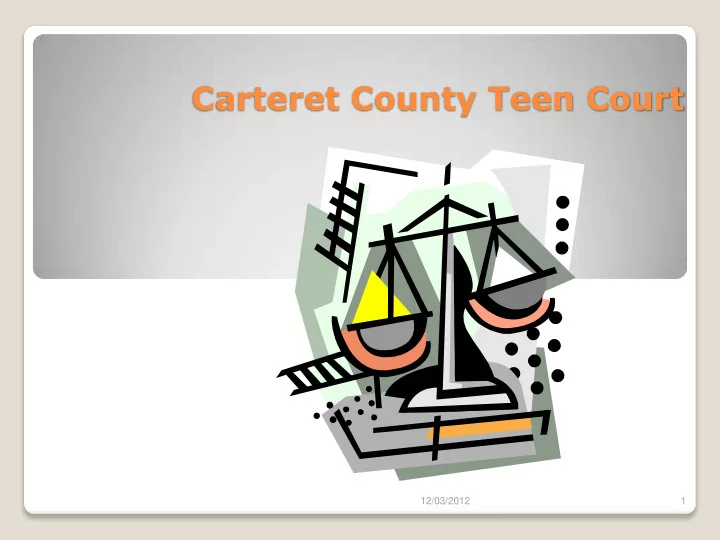

Carteret County Teen Court 12/03/2012 1
Brief overview of Teen Courts in NC Benefits of Teen Court Requirements for Referral Types of Offenses Non-eligible offenses Process for referral Court Session Dismissal Funding Statistics NCTCA Questions Topics of Discussion 12/03/2012 2
There are approximately 50 Teen Court Programs in the State of North Carolina. Teen Court allows the system to respond proactively and compassionately to juveniles at the first instance of any type of problem behavior. The program undercuts the permissive message that is often inadvertently sent when minor offenses lead to essentially “no response” from a system over-burdened with more serious offenders. The combined effect of this first response is that it requires accountability by the juvenile offender, while not creating any long lasting effects. This effort is laying important groundwork that will reduce the escalation of delinquent behaviors for many teens being impacted by this program. Teen Courts in North Carolina 12/03/2012 3
Juveniles brought before Teen Court that successfully complete sanctions will have no legal record of the offense Defendants learn to accept responsibility for their actions, learn the effects of their behaviors, learn good citizenship, experience self-esteem building and receive referrals to needed community resources through sanctions Long term behavioral changes are promoted which leads to enhanced public safety Negative labeling is reduced and the risk of recidivism is lowered Benefits of Teen Court 12/03/2012 4
Be 10 – 17 years of age (We will take 18 year old defendants who commit a misdemeanor in school or on school property) Be a full time student Admit guilt Not have a prior formal record Have committed a misdemeanor offense Requirements for referral 12/03/2012 5
Communicating Threats Intoxicated or disruptive on school property Property damage (less than $300) Shoplifting/Aiding & Abetting False calls to Emergency Services/Fire Alarms Trespassing Affray (fighting) Disorderly conduct Truancy Possession of weapon on school property (non-firearm) Misdemeanor possession of marijuana Assault (simple and moderate) Possession of alcohol on school property Runaway Types of Offenses 12/03/2012 6
Sexual offenses by youth, past or present Firearms offenses DWI or DUI Class A1 Misdemeanors Assault in which weapon used Controlled substance under Art. 5 of Chapter 90 of G.S. other than simple possession of a Schedule VI drug or alcohol Motor Vehicle Violations Non-Eligible Offenses 12/03/2012 7
SRO or Juvenile Court Intake Counselor completes a Teen Court referral form. Mail, fax or hand-deliver the referral and any additional paperwork that is necessary- Juvenile contact forms, police reports, discipline reports, etc. to the Teen Court Office. Teen Court Coordinator schedules an intake appointment with family to review policies and procedures, as well as schedule a Court Session for the defendant. Process for Referral 12/03/2012 8
Middle and High School student volunteers run the Court Room- Bailiff, Clerk, Attorneys, and Jury. Judge is an adult- procedural purposes only. Attorneys present the case and call the defendant to the stand for questioning. The jury listens to the case, then retires to render a fair and just sentence within the sentence guidelines. Jury returns for the reading of the constructive sentence. Court Session 12/03/2012 9
Juvenile offenders have 3 months from their Court Session to complete their constructive sentence. As long as everything is completed successfully, and no new charges have been filed, referral source is asked to drop the charges. Records are checked the month of dismissal, one year later, for recidivism data. Dismissal 12/03/2012 10
State Funded program through the Department of Public Safety, Division of Juvenile Justice- Juvenile Crime Prevention Council (JCPC). Send monthly disbursements to the county office, who then passes it on to each individual agency. Funding 12/03/2012 11
2011-2012 School Year- 98 Juvenile Offenders served. 98.7% of clients successfully completed their constructive sentence 98.7% of clients participating did not have any new petitions or court involvement while in Teen Court. 92.7% of referrals were admitted to the program. 91.8% of clients participating did not have new petitions or court involvement within one year of participating in the program. 98.7 % of clients participating in the program did not have any new suspensions. Does it work? 12/03/2012 12
◦ North Carolina Teen Court Association NCTCA 12/03/2012 13
Questions? Teen Court 12/03/2012 14
Recommend
More recommend